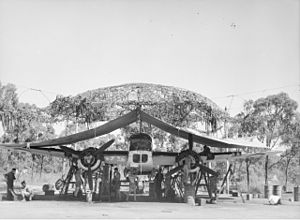No. 7 Squadron RAAF facts for kids
Quick facts for kids No. 7 Squadron RAAF |
|
|---|---|

A No. 7 Squadron Beaufort being serviced at Ross River
|
|
| Active | 1917–1919 1940–1945 |
| Country | Australia |
| Branch | Australian Flying Corps Royal Australian Air Force |
| Engagements | World War I World War II |
| Commanders | |
| Notable commanders |
John Balmer (1942) |
No. 7 Squadron was an Australian air force group. It helped train pilots in World War I. Later, in World War II, it became a squadron that flew bombers.
It started in England in October 1917. It was part of the Australian Flying Corps. The squadron was closed down in early 1919. The Royal Australian Air Force brought it back in June 1940. It started flying missions again in January 1942.
During World War II, it flew Lockheed Hudson and DAP Beaufort bombers. It took part in the Pacific War. The squadron was closed for good in December 1945.
Contents
Squadron's Early Days
No. 7 Squadron began during World War I. It was formed on October 24, 1917. This happened at Yatesbury, England. Its main job was to train pilots for the Australian Flying Corps (AFC).
They used many different types of planes. Training flights started in February 1918. The squadron sent new aircrew to No. 3 Squadron. It was closed down in early 1919. When it first formed, it was called No. 32 (Australian) (Training) Squadron. This was part of the Royal Flying Corps. Later, it became known by its AFC name. Captain H.D.E. Ralfe was its first leader.
World War II Service
Reforming the Squadron
During World War II, No. 7 Squadron was started again. This happened on June 27, 1940. It was at RAAF Station Laverton, Victoria, Australia. The plan was to give the squadron Lockheed Hudson planes. However, the unit was made smaller for a time.
The squadron was fully re-formed in January 1942. It became a Hudson operational training unit. Its job was to get aircrew ready for other squadrons. John Balmer was the squadron's commander. The squadron flew several missions. These included escorting ships and looking for submarines. They patrolled along Australia's eastern coast. In early June, one of their planes found a Japanese submarine. They attacked it and might have damaged it.
New Planes and Missions
Soon after, most of the squadron joined No. 1 Operational Training Unit. In August 1942, the rest of the squadron moved. They went to Nowra, New South Wales. Here, they received new planes. These were DAP Beaufort medium bombers. They started training to fly as bomber-reconnaissance planes. This means they would bomb and also look for enemy targets.
The squadron finished its training in October. They then moved to Ross River. This place was near Townsville, Queensland. From there, they flew patrols over northern Australian waters. They escorted ships in convoys. During these flights, their planes damaged another Japanese submarine. They also shot down two Japanese Aichi E13A "Jake" seaplanes. Several other enemy planes were damaged too.
Fighting in New Guinea
From April to October 1944, the squadron was based at Horn Island, Queensland. Then, they moved to Tadji, Papua New Guinea. From November 1944 until the war ended, they flew strike missions. They attacked Japanese positions in New Guinea. This helped the Australian 6th Division on the ground.
The squadron also helped rescue aircrew. These were pilots and crew who crashed behind enemy lines. No. 7 Squadron was officially closed down at Tadji. This happened on December 19, 1945. During the war, 33 people from the squadron died in action. Others died while serving.
Aircraft Used by the Squadron
The squadron flew these different types of aircraft:
- Airco DH.6 (October 1917 – 1918)
- Royal Aircraft Factory R.E.8 (October 1917 – 1918)
- Royal Aircraft Factory B.E.2 (October 1917 – 1919)
- Avro 504 (February 1918 – 1919)
- Bristol Fighter (February 1918 – 1919)
- Lockheed Hudson (January 1940 – August 1942)
- DAP Beaufort (August 1942 – December 1945)

